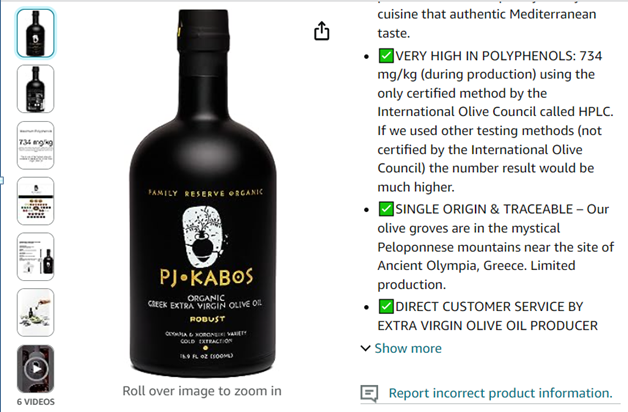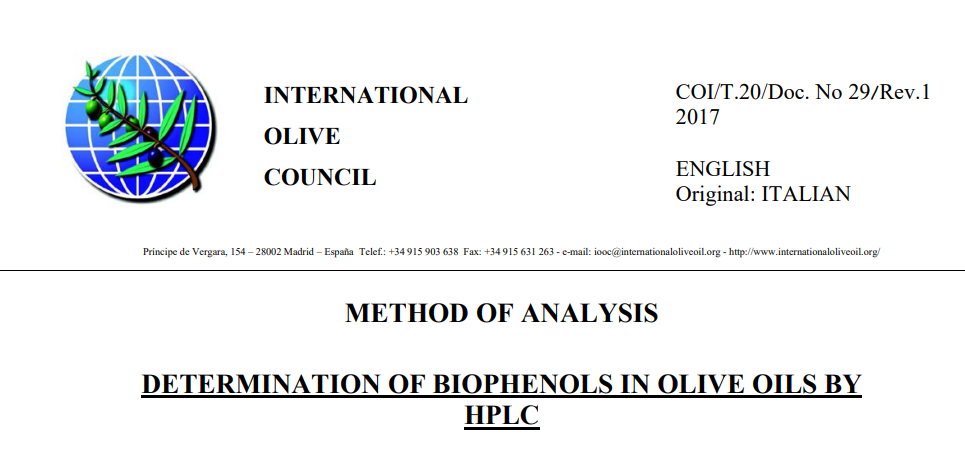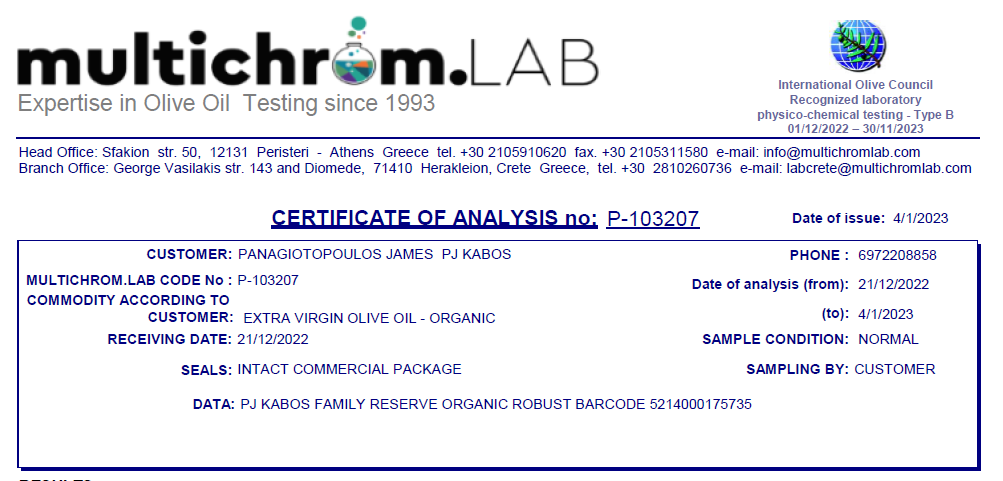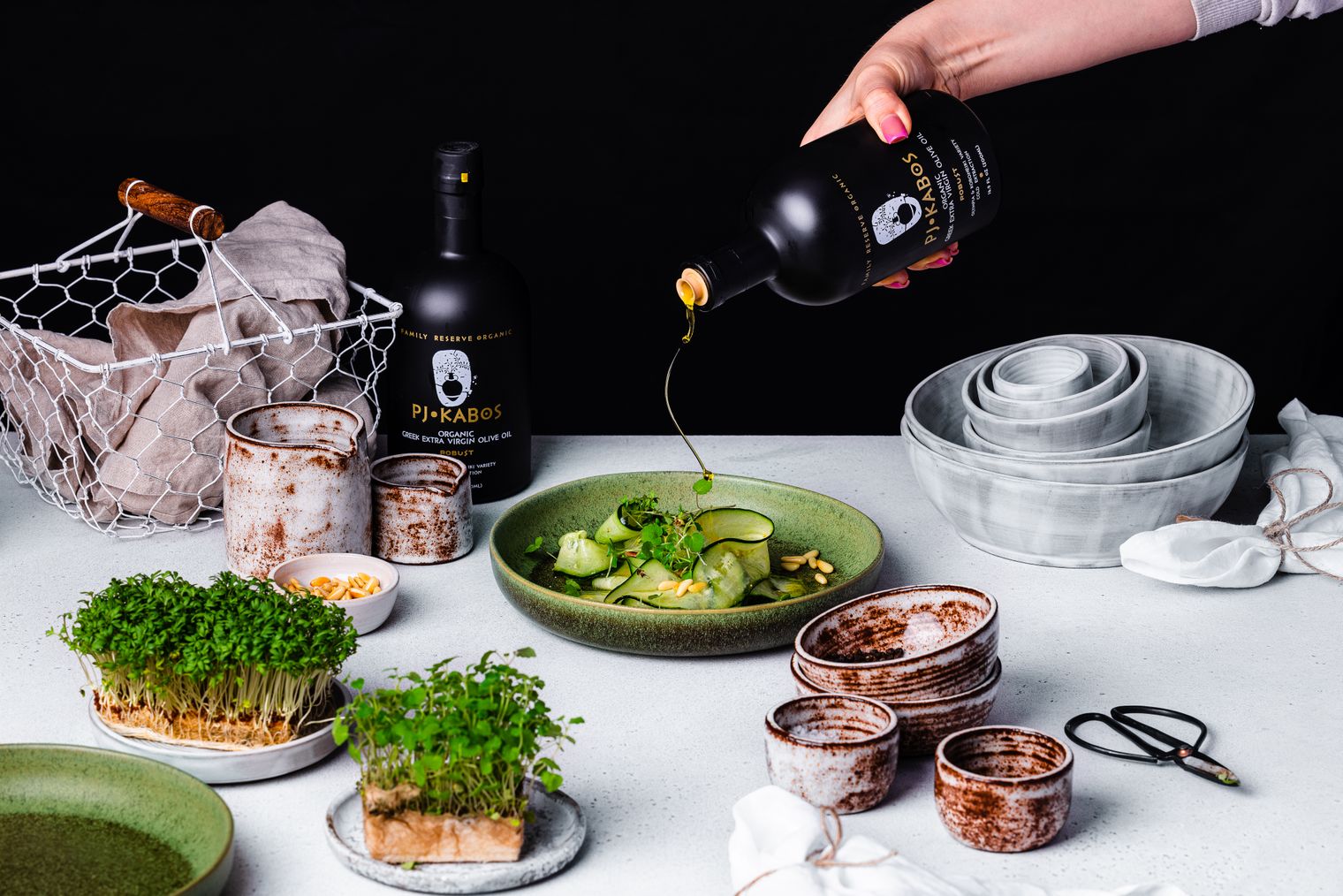On our Product Description page on Amazon we write concerning polyphenols for our Family Reserve Organic line of EVOO:
- ✅ VERY HIGH IN POLYPHENOLS: 734 mg/kg (during production) using the only certified method by the International Olive Council called HPLC. If we used other testing methods (not certified by the International Olive Council) the number result would be much higher.

- What exactly do we mean by this?
- What is HPLC?
- Why do we feel the need to qualify the method of testing used?
- And why is this important to you, the consumer?
To answer this, we must turn our gaze towards chemistry, a very common occurrence when dealing with a food product.

Chromatography
In analytical chemistry, there's a technique called chromatography. It helps separate, identify, measure, and analyze each part of a mixture and is widely used in various scientific and industrial fields, including pharmaceuticals, environmental analysis, forensics, food and beverage testing, and medical. By using chromatography, scientists can determine exactly what is in a mixture and how much of each component is present. Pretty cool! I think the ancients would have loved it!
HPLC
There are several types of chromatography but it is High-Performance Liquid Chromatography or better known by its acronym, HPLC, that we, as producers and consumers of food—in this case, High-Phenolic Extra Virgin Olive Oil—are interested in.

How a chemist analyzes phenolic compounds in EVOO
The “most” accurate method for analyzing phenolic compounds in Extra Virgin Olive Oil (EVOO) depends on various factors:
1) Specific Compounds of Interest
2) Concentration Range
3) Unit Measurements—Volume or Mass?
4) Analytical Objectives
5) Available Equipment.
Let’s look at these individually.
1) Specific Compounds of Interest
“Specific compounds of interest” refers to the particular phenolic compounds that a researcher or analyst aims to identify and quantify in Extra Virgin Olive Oil. Phenolics are a diverse group of bioactive compounds and different ones contribute to olive oil’s health benefits and antioxidant properties.
In the context of analyzing EVOO, researchers or producers might be interested in determining the concentration of specific phenolic compounds for various reasons. For example, some such as hydroxytyrosol and tyrosol, are known for their potent antioxidant and anti-inflammatory properties. These compounds are important for the health-promoting effects of olive oil and contribute to its stability and quality.
By specifying the “compounds of interest,” researchers can tailor their analytical methods to focus on those—and only those—particular phenolics during the analysis.
2) Concentration Range
In the context of testing phenolic compounds in Extra Virgin Olive Oil, the Concentration Range refers to the lowest and highest levels found.
It’s crucial to consider this range in order to ensure that the chosen analytical method is appropriate and can accurately detect and quantify the phenolic compounds within that array. Some methods of analyses might be more suitable for high concentrations, while others excel in detecting lower amounts. The approach chosen should be capable of covering the range relevant to the specific objectives.
Some extra virgin olive oils may have higher concentrations of phenolic compounds, while others may have lower levels. This aspect of testing provides valuable information about the intensity of phenolic compounds in the oil and how it may contribute to its health benefits and antioxidant properties.
3) Unit Measurements—Volume or Mass?
When analyzing EVOO for phenolics, the level can be measured in terms of the amount present in a given volume of the oil (milligrams per liter—mg/L—or parts per million—ppm) or secondly, by the amount of phenolic compounds per unit mass of the oil (milligrams per kilogram—mg/kg).
Both expressions are valid and provide the same information about the content, but the choice of measurement may depend on the specific analytical method used or the preference of the researcher or laboratory.
Using the second, mg/kg (milligrams per kilogram) is especially common when discussing the
phenolic content in terms of the oil’s mass, which is often the case when considering the impact
of the specific polyphenols on the overall quality and health benefits of EVOO. It allows for a
direct comparison between different oils, regardless of their volumes, providing a clearer
understanding of the phenolics present in the EVOO samples.
For example, for transparency sake and so that a ready comparison can be made by consumers between different brands of oils, PJ Kabos follows the protocols of the “International Olive Council” (IOC—see below) and our laboratory uses mg/kg. This way, both the consumer and we know exactly the level of phenols that are in the bottle under discussion.
4) Analytical Objectives
The specific goals or purposes of conducting an analysis must be taken into account.
Analytical objectives could vary based on the intended use of the data obtained from the analysis.
It could be that a producer is interested in determining if the phenolic content meets certain standards or regulatory requirements, or they may want to compare different olive varieties and geographical origins, or study how these factors influence the phenolic composition and quality of the oils for future growing seasons, or to ensure the authenticity and purity of a product, etc. Thus, the objective must always be a major consideration.
5)Available Equipment
Lastly but certainly not least, the equipment that is on hand in a laboratory for testing phenolic compounds can influence the choice of the analytical method used by producers. Some techniques may require more specialized and costly equipment, while others might be more accessible and suitable for routine quality control in production settings.
In cases where certain equipment is not available, laboratories may collaborate with other facilities or employ different testing methods that can be performed using the equipment they have on hand.
But different types of testing can cause real problems in consistency when comparing the phenolic value of various EVOOs.
Standardized Testing Methods
This brings us back to HPLC.
It is exactly this issue of discrepancies in regards to the above four factors that prompted the International Olive Council (IOC) in 2009 to recognize High-Performance Liquid Chromatography (HPLC) as the reference method for the “determination of biophenols in olive oils.” This was a game changer in the world of high-phenolic extra virgin olive oil as it finally presented a legitimate and comparable manner for all producers to analyze phenolics…and a way for consumers to know that the information they are given about the oil could be trusted… As long as the HPLC test was the one being used.
But what is the IOC?
In 1959, the United Nations established this intergovernmental organization, known by the name, The International Olive Council (IOC). It was, and still is, dedicated to ensuring trade standards for olive oil around the world. While many countries adopt the IOC’s guidelines directly, some may tweak the chemical test limits, and others may even incorporate supplementary tests to meet specific regional or marketing requirements.

Guidelines set by the IOC
However, the document by the International Olive Council (IOC) entitled, Determination of Biophenols in Olive Oil by HPLC, is a scientific paper that is meant primarily for the eyes of chemists. You might find it interesting to look at. (Copy and paste to your search bar: COI/T.20/Doc. No 29/Rev.1 2017.)
This is why section “7e” in the document is so important to producers.
To become a chemist takes years of study and few agriculturalist have such degrees. They must rely therefore on the integrity and expertise of these highly-trained specialists.
This section provides protection on many levels. All laboratories that do HPLC testing must have, among other points, detailed identification, show the date on which the test was performed, and have the signature of the testing supervisor. This ensures that the laboratories are reputable so that total trust and transparency can belong to the producers of high-phenolic olive oil who can then pass on this credible information to you, the consumer.

An example of an official laboratory result recognized by the IOC that was performed on our PJ KABOS example, Family Reserve Organic “Robust,” that the HPLC showed to contain 734 mg/kg polyphenols.

You may see the entire report on on PJ KABOS Amazon Product Page under “Product Guides and Documents”

Consistency in testing
By adopting the most current methods of testing backed by the IOC, producers ensure that all EVOOs around the world are able to be compared in the same manner. To compare two different methods with each other is like comparing apples to orange, and not to be trusted.
Or maybe, a better example is one James Panagiotopoulos, the founder of PJ KABOS—who is a former car racer—gave to me:
“100 miles per hour is much faster than 100 kilometers per hour even though the number “100” is the same. But the unit marker of miles and kilometers make all the difference in our understanding of the true value of the speed. It is the same with testing EVOO for phenolic content.”

Scientific testing is constantly improving upon itself and new methods are always brought forth. One such is Ultra High Performance Liquid Chromatography—UHPLC—which although seemingly very good, can only be used if everyone uses it. Maybe in the future it will be the approved IOC method. In which case, all reputable producers will use it so that correct and relevant comparisons between the phenolic components of different brands of EVOOs can honestly be made.
Conclusion –Testing Olive Oil with HPLC

Consistency allows for accurate and reliable results that can be judge against one another, making it easier for producers, researchers, and consumers to assess the quality and health attributes of different olive oils. It provides a level playing field and makes it harder for misinformation to be passed to the consumer, the primary objective of all olive oil producers of good reputation around the globe.
The amount of certain phenolic compounds found in EVOO, has been proven to be important to the oxidation of blood lipids. It is something that is quite rightly taken seriously these days.
If all producers use the IOC approved method—and state that they do—then that is information that you—the consumer—can use to compare brands in order to make informed decisions concerning the High-Phenolic Extra Virgin Olive Oil you wish to consume and give to your family.
It’s all about trust and for olive farmers and producers to bring to your table the very best product for your needs.





